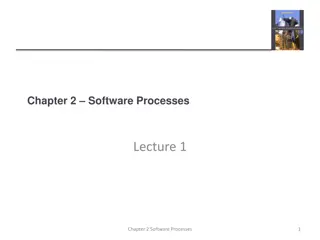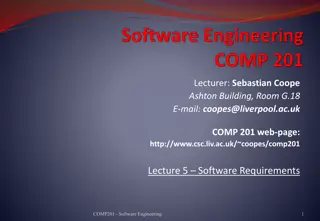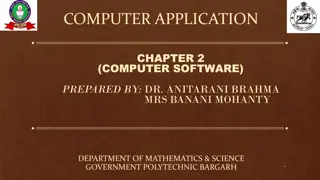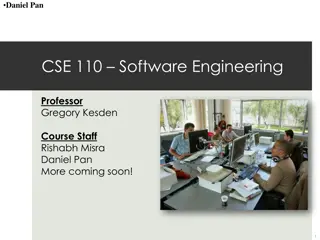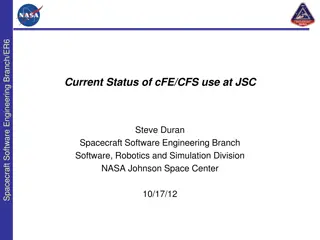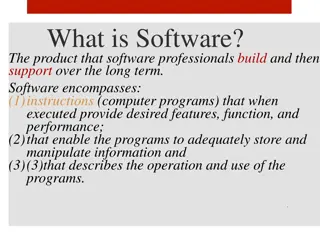Software Development
Software development involves the creation of programs and systems to solve problems efficiently. It encompasses programming, systems products, and the associated documentation and data. Despite being costly and labor-intensive, software development is crucial for technological advancements.
Download Presentation

Please find below an Image/Link to download the presentation.
The content on the website is provided AS IS for your information and personal use only. It may not be sold, licensed, or shared on other websites without obtaining consent from the author.If you encounter any issues during the download, it is possible that the publisher has removed the file from their server.
You are allowed to download the files provided on this website for personal or commercial use, subject to the condition that they are used lawfully. All files are the property of their respective owners.
The content on the website is provided AS IS for your information and personal use only. It may not be sold, licensed, or shared on other websites without obtaining consent from the author.
E N D
Presentation Transcript
Program. Programming System Product. Both of these are used to solve the problem but two are entirely different things. Much more effort and resources are required for Programming System Product
A Program is set of instructions that is generally complete in itself and is generally used only by the author of the program. There is usually little documentation. Since author is user presence of error is not the major concern. Here programs are not designed with such issues as portability ,reliability ,and usability.
A Programming System Product, on the other hand used by large number people other than developer of the system. User may be different background so proper interface is provided. There is sufficient documentation that help the diverse user to use the system. Programs are thoroughly tested before the use. portability ,reliability are key issues.
IEEE defines software as the collection of computer programs, procedures, rules, associated documentation and data. This definition clearly states that software is not just programs, but includes all the associated documentation and data. This implies that the discipline dealing with the development of software should not deal only with developing programs, but with developing all the things that constitute software.
1. Software is Expensive. 2. Late, costly and unreliable. 3. Problem of change and rework.
Due to advancement in technology, Cost of hardware has consistently decreased. But cost of software is increasing. Industrial strength software is very expensive primarily due to the fact that software development is extremely labor-intensive.
Cost of software involves, Size of software and manpower employed in developing it. Size of the software is measured interms of Delivered lines of code (DLOC). Manpower can be measured interms of person-month effort. Totally productivity is measured in industry interms of DLOC per person-month.
Despite considerable progress in techniques for developing software, software development remains a weak area. In a survey of over 600 firms, more than 35% reported having some computer-related development project that they categorized as a runaway. Runaway: it is one where the budget and schedule are out of control.
unreliability of software: The software does not do what it is supposed to do or does something it is not supposed to do. Software failure are different form of failures In software, failures occur due to bugs or errors that get introduced during the design and development process. Many bank have lost millions dollars due to inaccurate and other problems in software. It is clear that cost and schedule overruns and problem of reliability are major contributor to software crisis.
Once the software is delivered and deployed, it enters the maintenance phase. Why is maintenance needed for software, when software does not age? Software needs to be maintained not because some of its components wear out and need to be replaced, but because there are often some residual errors remaining in the system that must be removed as they are discovered. These errors, once discovered, need to be removed, leading to the software being changed. This is sometimes called corrective maintenance. The main reason is that software often must be upgraded and enhanced to include more features and provide more services. Maintenance due to this phenomenon is sometimes called adaptive maintenance.
Though maintenance is not considered a part of software development, it is an extremely important activity in the life of a software product. If we consider the total life of software, the cost of maintenance generally exceeds the cost of developing the software! The maintenance-to-development-cost ratio has been variously suggested as 80:20, 70:30, or 60:40.
Understanding the software involves understanding not only the code but also the related documents. During the modification of the software, the effects of the change have to be clearly understood by the maintainer because introducing undesired side effects in the system during modification is easy. To test whether those aspects of the system that are not supposed to be modified are operating as they were before modification, regression testing is done. Regression testing involves executing old test cases to test that no new errors have been introduced.
To control the software crisis some methodical approach is needed for software development. This is where Software engineering come in. Software engineering is defined as the systematic approach to the development, operation, maintenance, and retirement of software.
Another definition from economic and human perspective is given by Boehm by combining the dictionary s definition of engineering with it s definition of software. He states that Software engineering is the application of science and mathematics by which the capabilities of computer equipment are made useful to man via computer program, procedure and associated documentation.
The problem of scale. cost, schedule and quality. The problem of consistency. 1. 2. 3.
A fundamental factor that software engineering must deal with is the issue of scale development of a very large system requires a very different set of methods compared to developing a small system. In other words, the methods that are used for developing small systems generally do not scale up to large systems.
Consider the problem of counting people in a room versus taking a census of a country. Both are essentially counting problems. But the methods used for counting people in a room (probably just go row-wise or column-wise) will just not work when taking a census. Different set of methods will have to be used for conducting a census, and the census problem will require considerably more management, organization, and validation, in addition to counting.
Similarly, methods that one can use to develop programs of a few hundred lines cannot be expected to work when software of a few hundred thousand lines needs to be developed. A different set of methods must be used for developing large software. Any large project involves the use of technology and project management.
There is no universally acceptable definition of what is a "small" project and what is a "large" project. According to COCOMO(Constructive Cost Model) A project small if its size in thousand of delivered lines(KDLOC) of code is 2KDLOC, intermediate if size is 8KDLOC, medium if size is 32KDLOC and large if size is 128KDLOC.
In small projects, informal methods for development and management can be used. However, for large projects, both have to be much more formal, as shown in Figure 1.3.
A solution that takes enormous resources and many years may not be acceptable. Similarly, a poor-quality solution, even at low cost, may not be of much use. software engineering is driven by the three major factors: cost, schedule, and quality.
The cost of developing a system is the cost of the resources used for the system, which, in the case of software, is dominated by the manpower cost, as development is largely labor-intensive. Therefore, the cost of a software project is often measured in terms of person-months. i.e., the cost is considered to be the total number of person- months spent in the project.
Schedule is an important factor in many projects. Business trends are dictating that the time to market of a product should be reduced; that is, the cycle time from concept to delivery should be small. For software this means that it needs to be developed faster.
One of the major factor driving any production is quality. Now a days quality is a main mantra, and business strategies are designed around quality. Clearly, developing high-quality software is another fundamental goal of software engineering.
We can view quality of software product as having three dimension Product operation Product Transition Product Revision
Product operation deals with quality factors such as correctness, reliability and efficiency. Product transition deals with portability and interoperability. Product revision concerned with those aspects related to modification of the programs, including factors such as maintainability and testability.
Product operation deals with quality factors such as correctness, reliability, efficiency, Integrity and Usability. Correctness :is the extent to which a program satisfies its specifications. Reliability :is the property that defines how well the software meets its requirements. Efficiency :is a factor in all issues relating to the execution of software; it includes response time throughput and memory requirements. Integrity: It is the prevention of unauthorized or improper use of software. Usability: it is the effort required to learn and operate the software properly.
Product transition deals with portability, reusability and interoperability. Portability: It is the effort required to transfer the software from one hardware configuration to another. Interoperability: It is the effort required to couple the system with other system. Reusability: It is the extent to which parts of the software can be reused in other related applications.
Product revision concerned with those aspects related to modification of the programs, including factors such as maintainability ,Flexibility and testability. Maintainability: It is the effort required to locate and fix errors in operating programs. Flexibility : It is the effort required to modify an operational program. Testability: It is the effort required to test to ensure that the system or a module performs its intended function.
For some ultra-sensitive project, reliability may be of utmost important but not usability. For some commercial project like playing games usability may be of utmost important but not reliability. Hence for each software development project a project specific quality objective must be specified before development starts
Though high quality, low cost and small cycle time are primary objectives of any project for an organization there is another goal that is consistency. Software development organization would like to produce consistent quality with consistent productivity. Consistency of performance means organization should predicts the outcome of a project with reasonable accuracy and to improve its processes to produce higher quality products and to improve its productivity. Achieving consistency is an important challenge of software engineering has to tackle.
The basic objective of software engineering is to: Develop methods and procedure for software development that can scale up for large systems and that can be used to consistently produce high quality software at low cost and with a small cycle time. Consistency high quality low cost small cycle time scalability key objectives
Software development process must also have components of project management also otherwise scalability will not be achieved. To achieve consistency software development must be done in phases. Phased development Process is central to the software engineering approach.
A development process consists of various phases, each phase ending with a defined output. The main reason for having a phased process is that it breaks the problem of developing software into successfully performing a set of phases, each handling a different concern of software development. This ensures that the cost of development is lower than what it would have been if the whole problem was tackled together.
A phased development process is central to the software engineering approach for solving the software crisis. Various process models have been proposed for developing software. These process model consists of set of these activities: Requirement Specification. Design. Coding. Testing. 1. 2. 3. 4.
Requirements analysis is done in order to understand the problem the software system is to solve. The emphasis in requirements analysis is on identifying what is needed from the system, not how the system will achieve its goals. Communication gap can be bridged by using Requirement Analysis. Output of this phase is produce Software requirements Specification document.
The person responsible for requirement analysis is called Analyst. There are two major activities in this phase: Problem understanding or analysis Requirement specification 1. 2.
The purpose of the design phase is to plan a solution of the problem specified by the requirements document. It has major impact on the other phases. Output of this phase is design document. Design activity is divided into two separate phases: System Design Detailed Design 1. 2.
The goal of the coding phase is to translate the design of the system into code in a given programming language. Many of the details about coding the designs, which often depend on the programming language chosen, are not specified during design. The coding phase affects both testing and maintenance. Simplicity and clarity should be strived for during the coding phase.
Testing is the major quality control measure used during software development. Its basic function is to detect defects in the software. Testing not only has to uncover errors introduced during coding, but also errors introduced during the previous phases. Different levels of testing are used Unit Testing Integration Testing System Testing Acceptance Testing 1. 2. 3. 4.
Testing process starts with a test plan. The test plan specifies conditions that should be tested, different units to be tested, and the manner in which the modules will be integrated together. The final output of the testing phase is the test report and the error report. Each test report contains the set of test cases and the result of executing the code with these test cases. The error report describes the errors encountered and the action taken to remove the errors.



